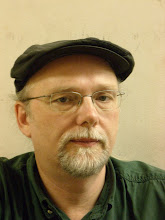Having said this, I'm not much of an expert on Daoist ritual, nor do I do much on a regular basis. One thing I have done for many years is have an altar to the Land God and which I "open" and "close" just about every day.

What I do is light a stick of incense, bow to the little altar, and ring a bell the when I first step out the door in the morning, and, when I step into the house for the last time at night. This is a ritual that we always practiced at the Daoist retreat centre I lived at many years ago. What it does for me (other than have my neighbours think I am nuts) is that it quiets my passionate soul and reminds me to think about the world around and within me---and what I owe it.
I also have an altar in my study which I have tried to develop a formal practice around, but which never seemed to "fit". So it has become more of a piece of sculture than an actual working shrine. Maybe at a future time it will become more important. Oddly enough, I had a film crew come in and shoot me offering incense to it as part of a legal battle I had with Walmart to protect a Jesuit retreat centre.

This isn't a very traditional altar, and I freely admit that I don't know much about this sort of thing. The three cloth paintings are supposed to depict some pretty key characters in my religious worldview: Chang San Feng, Laozi and Gandhi. Unfortunately, the artist I commissioned didn't check with me before she started the work, and as a result, she painted Chang San Feng (the founder of the internal alchemy school) riding an ox, which is a common way of depicting Laozi (or Lao tsu.) Gandhi isn't a tradition Daoist "Immortal", but he is an big influence on my life and he was known as a "Mahatma", or "great-souled one", which is pretty close to my understanding of Daoist "Xian". Moreover, there are lots of examples of non-Daoist deities in Daoist shrines, so it is pretty fair for him to be there.
Underneath the cloth banners I have a mantle with a "Hotei" (the laughing buddha.) He is traditionally known as an incarnation of Maitreya Buddha (the future Buddha) and is known for his sense of humour and patience---both things I am sorely lacking. The middle figure is a Guanyin, or Goddess of Mercy. Guanyin is also a Buddhist figure and is probably the most common figure on Chinese altars. She is very important to me as I believe that I have been repeatedly blessed with a visitation by her. The last figure is a Confucius, whom I also honour because even though I have never been a teacher, I am a scholar to my very bones.

Finally, underneathe my altar are the weapons I use in my taijiquan practice: a spear, straight sword (gim), sabre and dao. By putting them under my altar, I remember that my martial spirit must always be subservient to the teachings of religion. By the same token, they are there to ensure that I always wed my philosophy with action; and that I remember my responsibility to defend justice and Mother Nature.







3 comments:
from facebook:
May 8, 2007 at 8:18 AM
"Actually, my read of Zhuangzi is that various chapters have quite a few allusions to religious Daoism. Take for example his famous story of the "useless" tree. He refers to it as being the "Land God" of the region and it appears to him in a dream. The problem is that Westerners don't have the background to understand the allusions."
What is the difference between a constructed alter or shrine dedicated to the Land God and a natural object regarded as a manifestation of the Land God?
I read a Phd thesis by an anthropologist who studied land gods in Taiwan. There are still venerated sites there which consist of an oddly shaped rock or a very distinctive tree (i.e. like Zhuangzi's "useless" tree.) On the other hand, there are also individual figures that people buy and use for home shrines. There are also community land God statues that a village or city would use.
The thing about Daoism is that there doesn't seem to be any universally recognized tradition. Instead, there are local folk customs that are rooted in a specific part of the world. They bear resemblances with one another, but it is a "family resemblance" rather than any easily defined set of rules.
(You may meet people who deny the above, but my experience is that this means that they come from one specific localized tradition without having any experience of others. Sort of like if you were raised a Greek Orthodox Christian, never met or heard of Catholics, Methodists, etc, and had to explain Christianity to a Martian anthropologist.)
Land Gods in the Daoist tradition are at the lower end of the cosmic hierarchy. In fact, they are so low that I have heard of provincial magistrates taking the village God statue out of the shrine and having it whipped as punishment for allowing a drought to take place.
hi cloud walking owl
just stoped in to say hello, hope you are well.
don't know if you like taoist liturgies or not--i recently bought a copy of bruce frantzis "strings of the tao" and i am very pleased with it--for a big guy he has a great voice, their is a little seven string violin to acompany the songs and before each song he does a commentary on various aspects of taoism--its nice stuff, i think you would like it.
i,m still checking your site out here and there---i fully expect that some one will jump on me for makeing even this simple post--but i,m at a point now to where i can deal with it--ha, ha.
Post a Comment